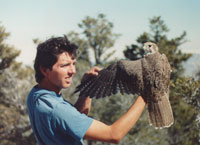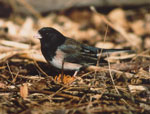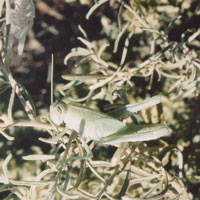|
In Pete Dunne’s book
Hawks in Flight he describes the western-dwelling prairie
falcon as the “...butte-haunting ghost of a falcon,
a prairie wraith.” Synonymous with open country, prairie
falcons utilize sandstone cliffs or towering buttes that
rim or interrupt these sparse grasslands or shrublands for
nest locations. Unless you are in their nest site vicinity,
one’s view of these prairie spirits is often a quick
sighting of a bird rapidly moving away.
Prairies are large, pale falcons. Their brown backs are a contrast to
the whiter underparts of the body and wing linings. One key identifying
field mark are the dark axillaries - the “armpit feathers” -
located where the wings meet the body, and are best visible while the
bird is in flight. The light brown mustache mark, which many might think
more of as a sideburn, offsets a small white patch on the birds cheek
(hence the mustache description). And the hooked or falcate shape of
the claws is the reference for the Latin word falco meaning falcon.
Like all falcons, the females are larger than males. On average, female
prairies are larger than the males by a couple of inches. When observing
a pair of falcons in courtship displays, it is easy to separate the sexes
by their size.
Prairies may initiate their breeding season in February or March. This
is an excellent time of year to view these raptors since the birds are
very vocal and active in their courtship displays. Loud wailing cries
or shrill whistling calls may easily betray their position; however,
I remember times of scanning a canyon wall section by section unable
to locate the wailing bird. Perhaps those rocky ledges went deeper than
I expected.
Some of my past bird work included monitoring prairie falcon nest sites
for disturbances or the production of young. These nest sites were as
different as the prey that these birds fed upon. Some sites were isolated
rocky towers with the birds utilizing a wide ledge or small alcove. Other
alcove or ledge sites were located on large cliff walls, either high
up on the cliff face or within 10' of the ground. Even abandoned raven
nests were used for prairie falcon nests.
As birds of open country, prairie falcons employ a couple of hunting
strategies. One, which is shared by many birds of prey, is to perch atop
a prominent outcrop, telephone pole or canyon rim, and visually search
for prey. The other method, which prairies use, is to fly low over the
ground and let the element of surprise flush some unsuspecting prey into
action. One time I watched a prairie falcon scare up a green-winged teal
from an old stock pond, then proceed to chase down the duck after a dizzying
chase that relied upon G-force maneuvers, Stuka dives and barrel rolls.
No wonder the U.S. Air Force adopted this bird as their official mascot.
Birds are not the only prey that prairies will go after. Small mammals
like ground squirrels, young prairie dogs or field mice, complement a
diet of lizards and grass-hoppers. Preferred are ground-dwelling birds
like horned larks, meadowlarks and mourning doves. Even burrowing owls
have been known to become a prairie falcon’s meal.
So as February buffers the transition period between winter and spring,
a birder’s to-do list may want to include some outings into the
drier portions of the outback to listen/look for these fleeting spirits
of the West.
|




|




